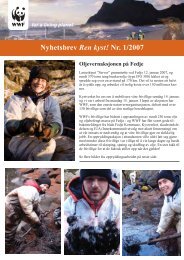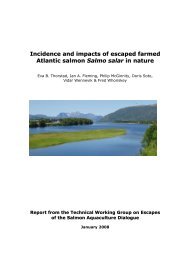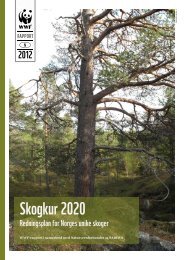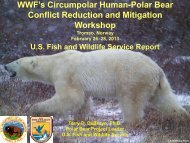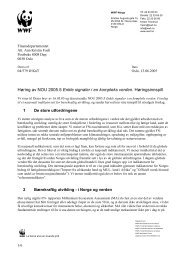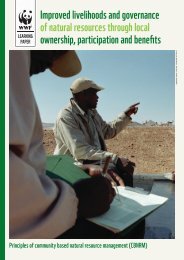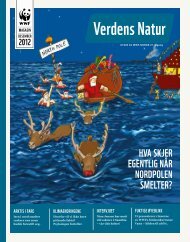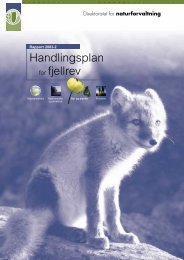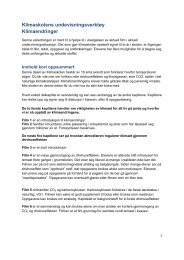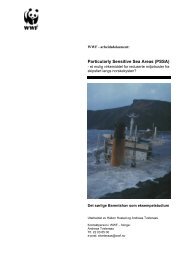Summary of the human-polar bear conflict reduction and ... - WWF
Summary of the human-polar bear conflict reduction and ... - WWF
Summary of the human-polar bear conflict reduction and ... - WWF
- No tags were found...
Create successful ePaper yourself
Turn your PDF publications into a flip-book with our unique Google optimized e-Paper software.
With support from<strong>Summary</strong> <strong>of</strong> <strong>the</strong> <strong>human</strong>-<strong>polar</strong> <strong>bear</strong> <strong>conflict</strong> <strong>reduction</strong> <strong>and</strong> mitigationworkshop, February 26-28, Tromsø, NorwayBackgroundLocal people <strong>and</strong> scientist report increasing interaction between <strong>human</strong>s <strong>and</strong> <strong>polar</strong> <strong>bear</strong>s since <strong>the</strong>1970’s <strong>and</strong> relate <strong>the</strong>se to deteriorating sea ice conditions (i.e. early break-up in <strong>the</strong> springpreventing <strong>polar</strong> <strong>bear</strong>s to reach <strong>the</strong> sea ice so that <strong>the</strong>y remain on shore). Global warming results inearlier sea ice break up, which forces <strong>polar</strong> <strong>bear</strong>s to spend longer time on shore where <strong>the</strong>y get incontact with people. Use <strong>of</strong> l<strong>and</strong> by <strong>polar</strong> <strong>bear</strong>s during <strong>the</strong> ice-free season appears to be increasing incertain locations, such as in <strong>the</strong> Sou<strong>the</strong>rn Beaufort Sea, <strong>and</strong> <strong>the</strong> Western Hudson Bay.A variety <strong>of</strong> measures are being implemented throughout <strong>the</strong> Arctic to reduce <strong>the</strong> potential <strong>of</strong><strong>human</strong>-<strong>polar</strong> <strong>bear</strong> <strong>conflict</strong>s <strong>and</strong> to make sure people <strong>and</strong> <strong>bear</strong>s can live safely in each o<strong>the</strong>r’s vicinity.Examples are <strong>polar</strong> <strong>bear</strong> patrols in Russia <strong>and</strong> Alaska, <strong>the</strong> distribution <strong>of</strong> <strong>bear</strong> safe bins for foodstorage, electric fences around camps <strong>and</strong> dog facilities, etc. There are many lessons to be learnedbetween <strong>and</strong> within <strong>the</strong> different Arctic countries on best practices to reduce <strong>and</strong> minimize <strong>human</strong><strong>polar</strong><strong>bear</strong> <strong>conflict</strong>s.To increase consistent collection <strong>of</strong> data on <strong>human</strong>-<strong>polar</strong> <strong>bear</strong> <strong>conflict</strong>s <strong>and</strong> biological data on <strong>polar</strong><strong>bear</strong>s throughout <strong>the</strong> Arctic, <strong>the</strong> Polar Bear Human Interaction Management System has beendeveloped for <strong>the</strong> <strong>polar</strong> <strong>bear</strong> Range States. In an earlier meeting between <strong>the</strong> Range States inChurchill, Manitoba, it was agreed to fur<strong>the</strong>r develop <strong>and</strong> implement <strong>the</strong> PBHIMS by allowing Russian<strong>and</strong> increased Norwegian participation, <strong>and</strong> to maintain momentum on this project ahead <strong>of</strong> <strong>the</strong> nextRange States meeting.Purpose <strong>of</strong> <strong>the</strong> workshopThe purpose <strong>of</strong> <strong>the</strong> workshop was to share best available knowledge <strong>and</strong> tools in <strong>human</strong>-<strong>polar</strong> <strong>bear</strong><strong>conflict</strong> <strong>reduction</strong> <strong>and</strong> mitigation amongst managers <strong>and</strong> experts from across <strong>the</strong> range states, <strong>and</strong>seek ways how <strong>the</strong>se can be made easily available <strong>and</strong> accessible. The workshop focused on: Sharing best practises in <strong>human</strong>-<strong>polar</strong> <strong>bear</strong> <strong>conflict</strong> mitigation measures from across <strong>the</strong>Arctic: What are best practices <strong>and</strong> lessons learned? What additional measures would beapplicable to Svalbard? How to fur<strong>the</strong>r improve <strong>the</strong> storage <strong>and</strong> retrieval <strong>of</strong> basic parameters in <strong>the</strong> circum-ArcticPolar Bear Human Interaction Management System (PBHIMS).This workshop brought toge<strong>the</strong>r over 35 pr<strong>of</strong>essionals from Canada, Greenl<strong>and</strong>, Norway, Denmark,Russia, USA, UK <strong>and</strong> <strong>the</strong> Ne<strong>the</strong>rl<strong>and</strong>s who have experience with <strong>human</strong>-<strong>polar</strong> <strong>bear</strong> <strong>conflict</strong>s <strong>and</strong> <strong>polar</strong><strong>bear</strong> conservation in a variety <strong>of</strong> pr<strong>of</strong>essions (conservationists, tour operators/ tourist guides,government, police, local people’s organisations) .Day 1. Introduction to <strong>conflict</strong> in Range States <strong>and</strong> <strong>conflict</strong> <strong>reduction</strong> in local communitiesThe first half <strong>of</strong> <strong>the</strong> day was used to give an overview <strong>of</strong> <strong>polar</strong> <strong>bear</strong> management, <strong>the</strong> history <strong>of</strong><strong>human</strong>-<strong>polar</strong> <strong>bear</strong> <strong>conflict</strong>s <strong>and</strong> <strong>the</strong> <strong>human</strong>-<strong>polar</strong> <strong>bear</strong> <strong>conflict</strong> situation in each <strong>of</strong> <strong>the</strong> Range States.Only Norway presented this on <strong>the</strong> third, all Norway- focused day. Main discussion <strong>and</strong> action pointswere:
- O<strong>the</strong>r non-lethal measures: electric fences, guard dogs, food storage, detection systems, tripwires,barriers <strong>and</strong> caging around houses <strong>and</strong> stairs, tazer guns.- Pair well trained patrollers with inexperienced ones as training programme.- Chukchi villagers perceived <strong>polar</strong> <strong>bear</strong>s as a serious threat but would ra<strong>the</strong>r not kill <strong>the</strong>m.More education is needed on <strong>conflict</strong> <strong>reduction</strong>.- Idea to institute a state inspector in every community , for centralized purchase <strong>of</strong> deterrents<strong>and</strong> to monitor migration patterns.Extra attention was paid to <strong>the</strong> use <strong>and</strong> effectiveness <strong>of</strong> <strong>bear</strong> spray. Common concerns are that it isnot effective, may affect <strong>the</strong> user or is influenced by characteristic Arctic conditions such as highwind <strong>and</strong> cold temperatures. However, <strong>the</strong>re are also very good experiences with <strong>bear</strong> spray. It hasbeen documented to be effective, <strong>and</strong> <strong>the</strong>re are also documented situation where experts can pointout that if used <strong>human</strong> <strong>and</strong> <strong>polar</strong> <strong>bear</strong> lives could have been spared. Before <strong>the</strong> actual spray reaches<strong>the</strong> <strong>bear</strong>, <strong>the</strong> animal is <strong>of</strong>ten startled by <strong>the</strong> sound <strong>the</strong> spray makes when released in <strong>the</strong> air. Bearspray is not for aversive use, for which o<strong>the</strong>r tools should be used. It is one <strong>of</strong> a number <strong>of</strong> optionsthat should be included when o<strong>the</strong>r long range deterrents have failed, or if one has <strong>the</strong> opportunityto use if from safe vantage point (structure or vehicle).The second half <strong>of</strong> <strong>the</strong> day was used to give an introduction on <strong>the</strong> PBHIMS <strong>and</strong> share preliminaryresults <strong>of</strong> <strong>the</strong> Range States which already worked with it. Main points were:- Database allows identifying <strong>conflict</strong> hotspots. And take targeted (efficient) managementmeasures to prevent fur<strong>the</strong>r <strong>conflict</strong>.- Next Steps: rolled out Arctic wide by 2015. Now populate <strong>the</strong> database (US <strong>and</strong> Norwaydone, Greenl<strong>and</strong> <strong>and</strong> Canada underway, Russia is still open). Set-up <strong>the</strong> application using <strong>the</strong>web to aide decentralized access (for managers <strong>and</strong> public) <strong>and</strong> upload data (by countryusing extended access options)- Issue <strong>of</strong> definition: some <strong>conflict</strong> kills are being reported as subsistence harvest kills, onlyactual <strong>conflict</strong> or also <strong>bear</strong> approaching settlement? Will be made clear in user’s manual.- Important contextual changes should be incorporated, e.g. when was a dump closed? Whendid <strong>polar</strong> <strong>bear</strong> patrols start? What was <strong>the</strong> sea ice condition? New industrial activity?- Need to record <strong>the</strong> collective behaviour <strong>of</strong> <strong>the</strong> group – was attack on group provoked or notprovoked? Important to take corrective measures in protocols when it turns out to beprovoked attack.- All this analysis interpretation is based on <strong>polar</strong> <strong>bear</strong>s killed in <strong>conflict</strong>! Need to somehowrecord interactions which did not result in casualties so that preventive measure’seffectiveness can be evaluated.- One way to get better data collection: for instance government agency requires recording <strong>of</strong>all interaction as a condition for issuance <strong>of</strong> permits.- Important to also upload <strong>polar</strong> <strong>bear</strong> sightings. In process <strong>of</strong> developing an automated formfor tourism <strong>and</strong> public to upload <strong>the</strong>ir information.- Possibilities <strong>and</strong> prospects <strong>of</strong> development <strong>and</strong> use <strong>of</strong> mobile APPs to allow increase ingeneration <strong>of</strong> cases (especially those which did not result in <strong>conflict</strong> + sightings) for science &management, <strong>and</strong> also to engage public (education) <strong>and</strong> even crowd sourcing.In <strong>the</strong> closing discussion <strong>of</strong> <strong>the</strong> day it was mentioned that attractant management is key <strong>and</strong> thatpeople need a better underst<strong>and</strong>ing <strong>of</strong> behaviour <strong>of</strong> both <strong>bear</strong>s <strong>and</strong> people. Learn to interpret <strong>the</strong>behaviour <strong>of</strong> <strong>polar</strong> <strong>bear</strong>s <strong>and</strong> how to respond to that. PBHIMS needs to become available for localcommunities <strong>and</strong> remote places.Day 3. Special focus on Svalbard <strong>and</strong> closing sessionThe third day was specifically focused on <strong>the</strong> <strong>human</strong>-<strong>polar</strong> <strong>bear</strong> <strong>conflict</strong> situation in Svalbard,Norway. During <strong>the</strong> first half <strong>of</strong> <strong>the</strong> day an introduction was given about <strong>the</strong> <strong>polar</strong> <strong>bear</strong> management
<strong>and</strong> <strong>polar</strong> <strong>bear</strong> <strong>conflict</strong> occurrence in Svalbard after which presentations were given about <strong>the</strong>tourism sector <strong>and</strong> <strong>conflict</strong>s. Tourism is an important sector for Svalbard <strong>and</strong> many tour operatorsface interactions with <strong>polar</strong> <strong>bear</strong>s. The main points from <strong>the</strong>se presentations were:- About 2 <strong>bear</strong>s are shot per year on average in defence <strong>of</strong> life <strong>and</strong> property.- The preferred line <strong>of</strong> action is to move a problem <strong>bear</strong> (hazing or translocation) <strong>and</strong> avoidshooting it.- Svalbard Tourism Board has set guidelines which are good to minimize negative encounters.However, expect always an unpredictable <strong>polar</strong> <strong>bear</strong>. It is not wise to travel around in <strong>polar</strong><strong>bear</strong> territory without an experienced guide.- Huskies prove to be excellent guard dogs <strong>and</strong> respond on <strong>polar</strong> <strong>bear</strong> presence (warning).- Guides should be trained in areas with many <strong>polar</strong> <strong>bear</strong>s, such as Churchill to really learnhow to interpret <strong>polar</strong> <strong>bear</strong> behaviour.- Tour guide steps when <strong>polar</strong> <strong>bear</strong> is encountered: not allowed to chase it etc. If <strong>polar</strong> <strong>bear</strong>scomes closer, <strong>the</strong>n guide has to withdraw <strong>the</strong> visiting group (100 – 70 meters). Then warningshots & flare gun (effective). If 40 – 30 meters <strong>and</strong> flares <strong>and</strong> shots make no effect <strong>and</strong> <strong>the</strong><strong>polar</strong> <strong>bear</strong> continues to approach, allowed to fire at <strong>the</strong> <strong>polar</strong> <strong>bear</strong>.- Can we avoid all visitor <strong>conflict</strong>s? No; but increased underst<strong>and</strong>ing <strong>of</strong> <strong>polar</strong> <strong>bear</strong> behaviouramongst visitors is important.- Visitors need to be aware <strong>of</strong> <strong>the</strong> unpredictable nature <strong>of</strong> <strong>polar</strong> <strong>bear</strong> behaviour. Curiosity caneasily shift to aggressive behaviour in a split second.- AECO likes to see common rules between countries on what kind <strong>of</strong> equipment is requiredfor guides.One <strong>of</strong> <strong>the</strong> presentations started a discussion about a fear based approach in <strong>conflict</strong> managementnow. Arriving on a scene in a mental state to be safe with a rifle means that we are <strong>the</strong>re in analready escalated state <strong>of</strong> mind. In Svalbard you are forced to take a gun <strong>and</strong> are thus forced to be inan escalated state <strong>of</strong> mind. Better to be present in a state <strong>of</strong> mind to avoid <strong>conflict</strong>. To have <strong>the</strong> gunalso results in panic reactions which fur<strong>the</strong>r escalate <strong>the</strong> situation. The dominant premise <strong>of</strong> <strong>the</strong> rule<strong>of</strong> <strong>the</strong> gun is fear-based, <strong>polar</strong> <strong>bear</strong>s are dangerous <strong>and</strong> shoot to kill as “management”. Suggestion:replace fear with underst<strong>and</strong>ing <strong>polar</strong> <strong>bear</strong>s. Polar <strong>bear</strong>s are more predictable than unpredictable.Management on <strong>the</strong> basis <strong>of</strong> knowledge, empathy <strong>and</strong> training. See <strong>polar</strong> <strong>bear</strong> as natural predatorsra<strong>the</strong>r than bloodthirsty animals. And <strong>polar</strong> <strong>bear</strong>s are a threat only if managed incorrectly. Guns arenot fool-pro<strong>of</strong>. Pepper spray is also not fool pro<strong>of</strong> but its use will save <strong>polar</strong> <strong>bear</strong>s from being shotinstead. Uneducated guides with rifles are much more dangerous – will result in more <strong>polar</strong> <strong>bear</strong>s<strong>and</strong> people getting killed in <strong>conflict</strong>. Combination <strong>of</strong> underst<strong>and</strong>ing <strong>and</strong> learning with a non-lethaldeterrent should be allowed in Svalbard. Need formal, obligatory training in <strong>polar</strong> <strong>bear</strong> <strong>and</strong> predatorbehaviour.During <strong>the</strong> second half <strong>of</strong> <strong>the</strong> morning attention was paid to <strong>polar</strong> <strong>bear</strong> management <strong>and</strong> research onSvalbard <strong>and</strong> <strong>the</strong> reconstruction <strong>of</strong> two well documented <strong>polar</strong> <strong>bear</strong> attacks on visiting tourists.- Individual travellers are encouraged to carry safety equipment. Campsites are required atleast 1 means <strong>of</strong> detection (i.e. keeping a <strong>polar</strong> <strong>bear</strong> watch routine which would fulfil thisrequirement – as well as watch dogs <strong>and</strong> tripwire as possibilities).- Current situation: not many incidents; most visitors with guides, few individual travellers;short stay <strong>of</strong> visitors; qualified guiding is needed; challenge however is still to provideadequate information to visitors.- Priorities for future: capture information from scientists, tourists <strong>and</strong> residents; specificconditions; updating PBHIMS.- Concern regarding pepper spray: It is readily available to <strong>the</strong> public <strong>and</strong> can be dangerous ifused incorrect (wind directions).- Old army trip wires are very effective <strong>and</strong> sure. Used by scientists, but difficult to obtain forpublic.
- Signal pistol is a good tool to scare <strong>polar</strong> <strong>bear</strong>s away. But do not get <strong>the</strong> flare behind <strong>the</strong><strong>polar</strong> <strong>bear</strong> – it will drive <strong>the</strong> <strong>polar</strong> <strong>bear</strong> towards you. Keep on training with all weapons tomaintain ability to operate quick <strong>and</strong> efficiently.- Dart guns with only a needle work effectively to scare away <strong>polar</strong> <strong>bear</strong>s- Tempelfjorden case: A British student <strong>and</strong> group leader were killed, <strong>and</strong> two o<strong>the</strong>rs injuredby a <strong>polar</strong> <strong>bear</strong> while camping on shore with a group <strong>of</strong> students. The <strong>polar</strong> <strong>bear</strong> had passed<strong>the</strong> trip wires without setting it <strong>of</strong>f <strong>and</strong> one <strong>of</strong> <strong>the</strong> group leaders was unable to unlock hisgun.- Extremehuken case: two kayakers were attacked on shore; <strong>the</strong> <strong>polar</strong> <strong>bear</strong> broke through <strong>the</strong>trip wire without setting it <strong>of</strong>f <strong>and</strong> dragged one guy out <strong>of</strong> his tent. Also stepped on <strong>the</strong>shotgun which could no longer be used. The o<strong>the</strong>r guy eventually found a rifle <strong>and</strong> shot <strong>the</strong><strong>bear</strong>. Victim survived- Main lesson learned from <strong>the</strong>se cases: <strong>the</strong> alarm systems did not work <strong>and</strong> cannot be fullytrusted- In <strong>the</strong> last incident people kept food in <strong>the</strong>ir tent <strong>and</strong> camped too close to <strong>the</strong> shore. Peopledo get instructions on where to camp or prepare/ store food but may need to be improvedIn <strong>the</strong> afternoon <strong>the</strong> group was split into four groups to have discussions about <strong>the</strong> following topics:A. Human DimensionsB. Bear Behaviour ResearchC. Tools <strong>and</strong> MethodsD. PBHIMS / Data CollectionThe groups used <strong>the</strong> following questions to guide <strong>the</strong>ir discussions <strong>and</strong> to look for future possibilities<strong>and</strong> follow up after this workshop:1. What are knowledge / funding gaps?2. Focal pilot areas in each country?3. What are <strong>the</strong> top 3 activities to advance progress in addressing <strong>human</strong> – wildlife <strong>conflict</strong>in <strong>the</strong>se sections?Main conclusions <strong>of</strong> each <strong>of</strong> <strong>the</strong> groups:Group A. Human dimensions1. People (local people, scientists, tourists) need more knowledge <strong>and</strong> underst<strong>and</strong>ing <strong>of</strong> <strong>polar</strong><strong>bear</strong>s, <strong>the</strong>ir behaviour <strong>and</strong> how to respond to that.People judge by situation, everyone has a different perception <strong>of</strong> risk, so move away fromfixed rules. Risk perception is connected to knowledge so important to improve thatLocal knowledge should be used for newcomers <strong>and</strong> guides should do exchange visits witho<strong>the</strong>r places.2. Exchange visits between countries in nor<strong>the</strong>rn countries, with use <strong>of</strong> exchange funds t<strong>of</strong>acilitate this. Important aspects are body language <strong>of</strong> <strong>bear</strong>s <strong>and</strong> people. For people who livenear <strong>polar</strong> <strong>bear</strong> should underst<strong>and</strong> <strong>polar</strong> <strong>bear</strong> body language.Example <strong>of</strong> project where you film a group <strong>of</strong> elders, scientists <strong>and</strong> at same time <strong>bear</strong>behaviour. People explain what <strong>the</strong>y see <strong>and</strong> analyse behaviour. Also analyse videos <strong>of</strong><strong>human</strong> behaviour when interacting with <strong>bear</strong>s (like <strong>the</strong> one with <strong>the</strong> <strong>bear</strong>s pray) what isproper behaviour <strong>and</strong> what not. Also on deterrent methods, videos <strong>of</strong> <strong>the</strong> effect <strong>of</strong> ameasure on <strong>the</strong> <strong>bear</strong> like rubber bullet, electric fence etc.All toge<strong>the</strong>r gives better view <strong>of</strong> people <strong>and</strong> <strong>bear</strong> behaviour <strong>and</strong> effects <strong>of</strong> deterrence.People may have a better underst<strong>and</strong>ing <strong>of</strong> that <strong>and</strong> react more appropriately.Could use a videogame with situations to practice, scenarios with variables. For people onshore, in boats, etc.
Not only 'educate ' people but select situations where it is most needed.Group B. Bear behaviour research1. Gaps <strong>and</strong> focal projects to follow-up:a. Knowledge on predictability <strong>of</strong> <strong>bear</strong> behaviouri. Need expert workshop to compare observed behaviour across species toaddress questions such as a) how could ecological behaviour be leveragedfor better prevention (how do <strong>polar</strong> <strong>bear</strong>s learn?), b) do <strong>polar</strong> <strong>bear</strong>s behavesimilar to o<strong>the</strong>r species (general wisdom is <strong>the</strong>y are different but not tested)1. Action: exp<strong>and</strong> planned <strong>conflict</strong> workshop by Doug Clark in Churchillto not just focus on Canada. <strong>WWF</strong> can cooperate with expansionii. Have experts review / interpret <strong>bear</strong> behaviour queues (yawn, smacking,etc.) on videos linked to described <strong>conflict</strong> situations1. Action: have range states request a study <strong>and</strong> compilation <strong>of</strong> videos,etc. Could be a funded research project2. Team <strong>of</strong> 2-4 experts visit <strong>conflict</strong> hotspots (e.g. Kaktovik, Barrow,Churchill, Svalbard, Chukotka) to compare behaviour directly toavoid biases. Report to Range States Meeting.iii. Connect more with zoo keepers, trainers, <strong>and</strong> traditional knowledge toexchange knowledge on behaviour (discussed <strong>the</strong> “Do <strong>bear</strong>s smile” research)1. Action: invite to expert workshopiv. Which <strong>bear</strong> behaviours could be influenced by deterrence measures1. Action: Design research program on effective deterrence (somecould be tested in Wapusk compounds with Doug Clark’s on-goingprograms)Group C. Tools <strong>and</strong> methods1. Behaviour training:- Bear behaviour <strong>and</strong> ecology, in general <strong>and</strong> especially as it relates to <strong>bear</strong>s in communities.- Training <strong>and</strong> increased knowledge in <strong>the</strong> available methods <strong>of</strong> <strong>polar</strong> <strong>bear</strong> deterrence.- St<strong>and</strong>ardized <strong>and</strong> comprehensive training manual (with accompanying video) to be used byall Range States.- Workshops for operational staff (e.g. <strong>polar</strong> <strong>bear</strong> monitors, eco-tourism leads) throughout <strong>the</strong>Range States.- Circum<strong>polar</strong> training st<strong>and</strong>ards for <strong>polar</strong> <strong>bear</strong> monitors (firearms, deterrence techniques,<strong>bear</strong> behaviour etc.). Reference was made to work done by Andy McMullen in Canada. Theidea here is to bring toge<strong>the</strong>r existing expertise <strong>and</strong> share it effectively.- M<strong>and</strong>atory, annual refresher courses (i.e. re-qualification) for those on-<strong>the</strong>-ground in: <strong>bear</strong>behaviour, firearm use (competence), deterrence training etc.- Mechanism for sharing <strong>of</strong> difference experiences with <strong>the</strong> different tools that are available(e.g. pepper spray)- Legal analysis <strong>of</strong> tools permitted in <strong>the</strong> various Range States (e.g. pepper spray in Norway)2. Canada – suggested continued work in Churchill/ Wapusk National Park in ManitobaRussia – suggested a renewed connection between <strong>the</strong> Special Chemistry Institute <strong>and</strong> <strong>the</strong> NatureProtection Institute to test pyrotechnic/noise projectiles. Also interested in chemical projectiles.Greenl<strong>and</strong> – suggested use <strong>of</strong> Greenl<strong>and</strong>ic dogs, especially close to settlementsNorway <strong>and</strong> <strong>the</strong> United States – nothing suggested3. Training:- Manual <strong>and</strong> video- Workshops
- Continued research into “new” techniques (pepper spray, noise cannons, tasers, newprojectiles etc.)/Ultimately: circum<strong>polar</strong> st<strong>and</strong>ards adopted by all Range States.Group D. PBHIMS/ data collection1.a. integration <strong>of</strong> data (sheets) collected by <strong>polar</strong> <strong>bear</strong> patrols <strong>of</strong> North Slope Borough in PBHIMS– after updating PBP data sheets to match <strong>of</strong> PBHIMS variables (US)b. adapt Chukotka Polar Bear Patrol data sheets to fit PBHIMS variables as much as possible tobe more suitable for local communities (hunters), <strong>and</strong> <strong>the</strong>n make data sheets available toPBHIMS data entry point person Anatoly Kochnev (Chukotka branch <strong>of</strong> TINRO)c. integration <strong>of</strong> reports (film, pictures) involving encounters with <strong>polar</strong> <strong>bear</strong>s from scientists &filmers, tour operators, media stations (e.g. BBC) into PBHIMSd. translations <strong>of</strong> database in Russian, 3 native Canadian languages, Greenl<strong>and</strong>ic, Frenche. development <strong>of</strong> a web-based platform to enter <strong>and</strong> retrieve dataf. western Hudson Bay pilot needs to be uploaded in PBHIMSg. decide which <strong>of</strong> <strong>the</strong> multiple Canadian agencies involved in <strong>polar</strong> <strong>bear</strong> management will takeresponsibility for collecting <strong>and</strong> uploading data for <strong>the</strong> o<strong>the</strong>r 15 Canadian sub-population.h. develop a portable app for data forms which can be filled-in anywhere in <strong>the</strong> field.i. <strong>WWF</strong> <strong>human</strong> <strong>polar</strong> <strong>bear</strong> <strong>conflict</strong> demonstration programmes collect data compatible withPBHIMS database variables.j. Russian – English speaking graduate student to work with Edward <strong>and</strong> Anatoly to collect<strong>conflict</strong> information in Chukotka.k. Student collecting old <strong>conflict</strong> records from police reports, newspapers etc. in Greenl<strong>and</strong>.2. Integrated in gaps above3. See points a, b <strong>and</strong> c aboveFinal notes <strong>of</strong> <strong>the</strong> workshop <strong>and</strong> points <strong>of</strong> attentionPBHIMS:- PBHIMS could be driver for effective fundraising since it shows hotspots <strong>and</strong> could aid inidentifying effective deterrence <strong>and</strong> prevention measures with actual data- Need to have focal points assigned in each country to feed data into system (not yetappointed in Russia <strong>and</strong> no data provided yet).Knowledge sharing:- There needs to be more knowledge sharing between <strong>the</strong> experts on various <strong>bear</strong> speciesa. Behaviourb. Deterrencec. Preventions (e.g. fences, compensation programs, etc.)d. Hunting/predator management- Bear Spray: is an effective tool for last-ditch effort to avoid being killed (self – defence) butshould not be used as a replacement <strong>of</strong> protection with firearms or as a deterrence tool.Funding:- Need to identify clearer budgets on costs <strong>of</strong> prevention / deterrence programs. Peoplementioned various numbers but some included staff time, o<strong>the</strong>rs not. No st<strong>and</strong>ardized way<strong>of</strong> estimating costs makes it hard to compare effectiveness- There should be a concerted effort to look at effective funding mechanisms <strong>of</strong> <strong>conflict</strong>mitigation via for example Tourism fees, to establish compensation <strong>and</strong> response funds, etc.





